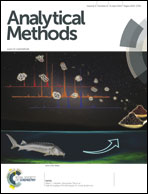Hollow fiber liquid based microextraction combined with high-performance liquid-chromatography for the analysis of lidocaine in biological and pharmaceutical samples
Abstract
This work presents a hollow fiber liquid–liquid–liquid microextraction (HF-LLLME) technique for extracting lidocaine from human plasma, urine and injection vial samples. It was combined with high-performance liquid-chromatography-ultraviolet detection (HPLC-UV). In this experiment, lidocaine was successively extracted from a sample donor phase into several microliters of an organic phase and then from the organic phase into an aqueous extract acceptor phase. The following separation and quantitative analyses were performed using HPLC/UV with 205 nm detection. Extraction conditions such as solvent selection, acceptor phase pH and donor phase pH, agitation rate, extraction time and salt addition effect were investigated and optimized. Under optimum conditions, a limit of detection (LOD) of 0.01 μg mL−1, a linear range of 0.05–2 μg mL−1 (n = 9) and a correlation of determination (R2) of 0.9994 were obtained. The intra-day relative standard deviation based on three replicate determinations in one day for three days for 0.8 μg mL−1 was 8.2% and inter-day relative standard deviations (RSD%) based on five replicate measurements in one day for 0.8 μg mL−1 and 0.08 μg mL−1 were 2.01% and 6.90%, respectively. Extraction and determination of lidocaine in human plasma, urine and injection vial samples were successfully performed.


 Please wait while we load your content...
Please wait while we load your content...